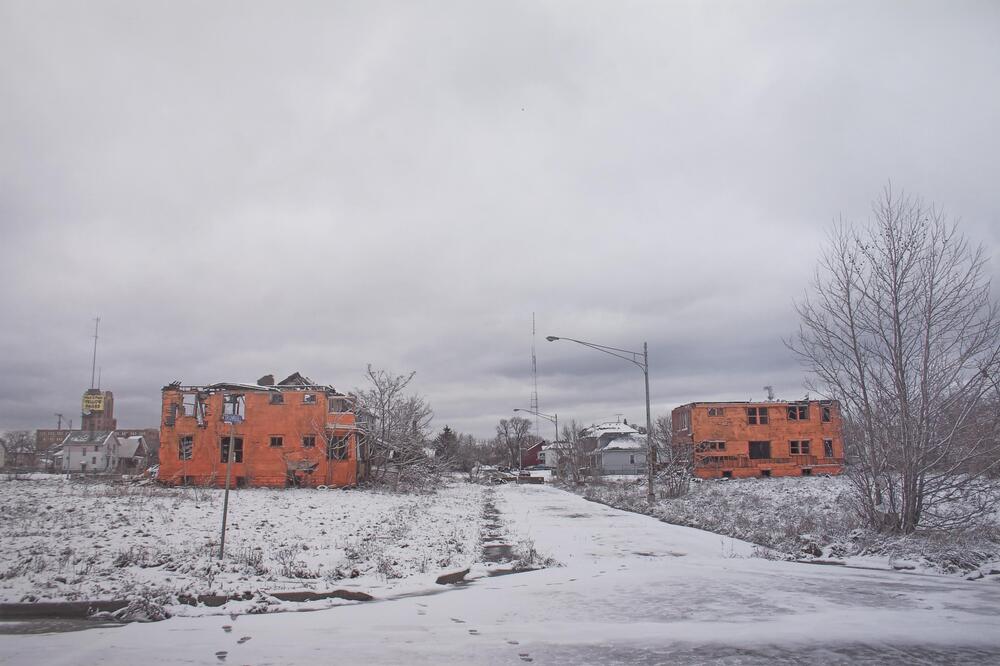Lesson Plan: Setting Up a Collaborative Short Story
“Teaching with Landscape Photography,” UMMA Teacher Workshop, November 6, 2013
Objectives
Students will create a short story based on the setting of a landscape photograph.
National Core Standards
- Write narratives to develop real or imagined experiences or events using effective technique, well-chosen details, and well-structured event sequences.
Grade
6-12
Time Required
One class period for writing, one for revision
Materials
- Landscape photograph or photographs, such as UMMA’s “Auburndale Site”
- Paper, pencils, writing materials
Lesson
- Define Landscape: can landscape be a city? Can it include people? If so, how is does it differ from a portrait or a documentary photograph? Can it be abstract? Is it a snapshot of any “land” or does it need to adhere to some conventions to be “landscape”? How should we think about aerial photography? If possible, show different examples of paintings or photographs to illustrate and compare/contrast. Some images might include Atget, Stieglitz, Cartier-Bresson, Curtis, Weston.
- Show Object Orange’s “Auburndale Site, Highland Park #3.” Does this photograph fit the criteria for a landscape? What is it? It is urban, but no people are present. It is not abstract.
- Introduce writing activity. It is a creative writing collaborative assignment but includes individual components, and you will write about this specific place. Please find a group of four.
- Assign one role to each student, possibly handing them a strip of paper with their role / assignment:
a. Place – describe this place in detail. You do not need to go beyond and try to analyze or imagine.
b. Mood – what is the mood of this place? Include clues from the photograph that give you a sense of emotion or mood.
c. Character – who might live here? Animals? People? If no one lives here, who might visit? Why?
d. Problem or issue / conflict –
- Students will write about their task for about 5 minutes. If time allows, push towards visual analysis. When writing about mood, ask what artistic choices contribute to the conveyed emotion and total effect – ex: position of horizon line, light, season, composition.
- Share paragraphs with the small group. How do the pieces fit together? What did a partner think about that you hadn’t considered? Combined, do they create a viable story? Students can perhaps revise their original contributions to make a more cohesive short story.
Additional Information: Background of Object Orange and “Auburndale Site.” It may be helpful to not share this with students until after they have written.
a. Object Orange is a group of artists who choose to remain anonymous in order to protect themselves from litigation or police action. Their goal is to raise awareness of the plight of abandoned houses in Detroit. They want “everyone to look at not only these [orange] houses, but at all the buildings rooted in decay and corrosion.” Out of this awareness of place, they hope to bring action and change.
b. Object Orange began as a project entitled “Detroit. Demolition. Disneyland.” First, they found abandoned houses situated next to major highways in order to ensure high visibility for suburban commuters. Next, the artists coated every surface—boards, windows, doors—Tiggeriffic Orange, part of the Mickey Mouse paint series found at Home Depot. Why orange? Similar to the safety orange sported by hunters and traffic cones, it is impossible to miss. When they finished painting, they photographed the house to document it before, hopefully, it was torn down by the city. This particular photograph of a house, located on Auburndale Street in Highland Park, is part of a series from 2007. similar landscapes in the series featured cracked roads, overgrown weeds, leaning lampposts. The exhibition catalog includes before and after photographs, highlighting the transformation of an average decrepit brown or brick building into a brightly-colored attraction. Also, painting the house one solid color unifies the broken windows and jagged boards; it flattens the façade and turns glass and wood into a formal study of line and texture. In Auburndale #3, the austere and cold surroundings contrast with the bright house and provide juxtaposition and tension. The heavy gray sky, low horizon line, and leafless winter trees also contribute to a dismal feel. That there are no other buildings or people around is confusing, as it is an urban setting, which we typically associate with activity and commerce. Object Orange’s project is complex. It includes 1. a physical house, 2. a printed photograph, and 3. an intangible social component. The photograph provides documentation for the entire project, ensuring that it will be remembered and perhaps perpetuated.
Part of 1 Learning Collection
“Tradition Transformed: Chang Ku-nien Master Painte...
“Creative Literacies: Expanding our View,” UMMA Wor...
UMMA Exhibition, “The Graphic Dimension: Prints and...
“Creative Literacies: Expanding our View,” UMMA Wor...
“Teaching with Photography,” UMMA Workshop for Educ...
“Creative Literacies: Expanding our View,” UMMA Wor...
Lesson adapted from Educator Resources, Victoria & ...
“Benjamin West: General Wolfe and the Art of Empire...
“Creative Literacies: Expanding our View,” UMMA Wor...
“Teaching with Photography” UMMA Teacher Workshop,...
Lesson inspired by Elaine Wilson’s “Charting the Wo...
“Tradition Transformed: Chang Ku-nien Master Painte...
UMMA Teacher Workshop, “Xu Weixin: Monumental Portr...
“Teaching with Photography,” UMMA Workshop for Educ...
“Teaching with Landscape Photography,” UMMA Teacher...
UMMA Teacher Workshop, “Xu Weixin: Monumental Portr...
“Creative Literacies: Expanding our View,” UMMA Wor...
Tags
CharacterConflict
Description
Detroit
Landscape
Lesson
Mood
Photograph
Photography
Short story
Urban
Writing
Rate this Resource
AVG: 0 | Ratings: 0
& Author Notes
Creative Commons by-nc-sa (Lesson created by Grace VanderVliet)Last Updated
March 6, 2017 1:19 a.m.Report
Reporting Policy

